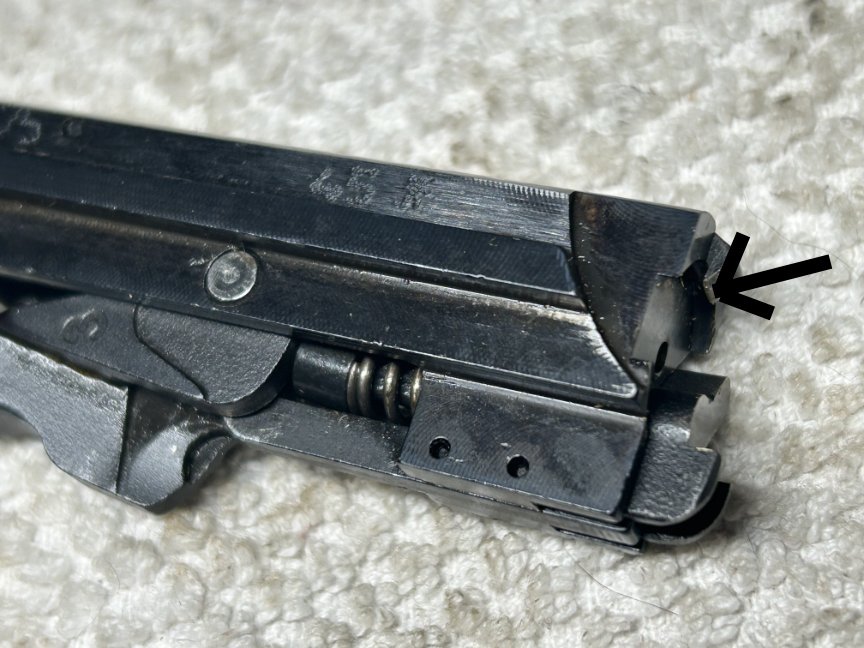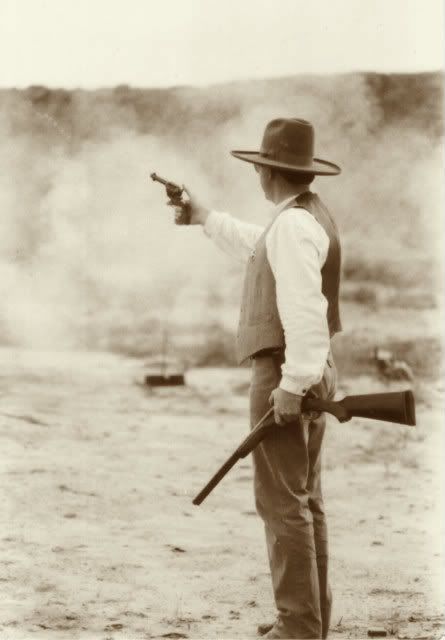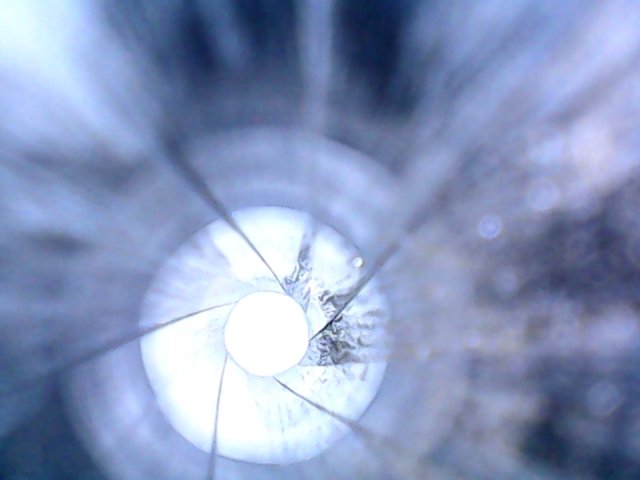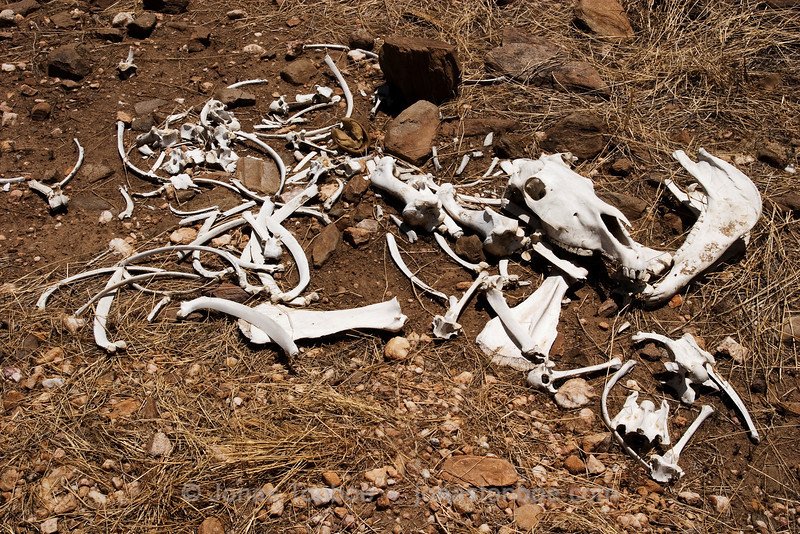-
Posts
7,347 -
Joined
-
Last visited
Content Type
Profiles
Forums
Events
Posts posted by Griff
-
-
The .44 cylinders require the frame to be "notched" to fit. I don't know if the arbor dimensions are different. I don't have any .44s measure, maybe someone else does? But, as the barrels would also require being changed out, there may be an issue with the barrel locating pin placement.
-
I read on another forum that it was HSM Cowboy loads. From 2022: https://singleactions.proboards.com/thread/35088/45-colt-small-primer
-
 1
1
-
 1
1
-
-
1 hour ago, Rancho Roy said:
Can't use Gas Checks in Cowboy Long Range matches.......
Au Contraire. as per the SHB, pg 30:
Quote- Regardless of category or caliber, bullets used in long range and precision rifle matches must be made of pure lead or lead alloy having a plain base, gas checked, or paper patched configuration.
Emphasis added. Local rules may vary.
-
 1
1
-
-
Actually, the .38-55 was introduced by the Ballard Rifle Co. in 1876, based on their earlier .38-50 Everlasting. Winchester didn't chamber a rifle in it until the 1894. Marlin using it in their mdl 1881, far earlier than Winchester. The four "dash calibers" that Marlin refused to put on their rifle barrels were the 25WCF, 32WCF, 38WCF & 44WCF, using instead the 25-20, 32-20, 38-40 & .44-40 nomenclature.
Whereas the .32-40 was also introduced in the mdl 1884 Ballard and subsequently used by both Marlin and Winchester. It was never a "WCF" cartridge. That distinction was reserved for the .32-20.
-
FYI, the below picture has had an arrow added to it indicating the hook of the extractor. Your dummy cartridge should be able to be placed behind this hook, against the bolt face to facilitate prying the ejector back into the bolt. If you were unable to do this either the extractor is too short or it was cut too shallow. The rim thickness for a 45 Colt is `.060". The distance from the inside of the hook to the bolt face must be at least this distance, otherwise the extractor cannot drop over the rim to extract the case from the chamber. I don't actually use a dummy cartridge as an assembly aid, just a empty case... works as well.

If you have a dial caliper, and haven't sent the rifle back yet, measure that distance and include the actual measurement in a note accompanying the rifle. I'd also measure the inside radius of the bolt hood, that "arc" covering the rim over the top of the bolt. The rim diameter for the 45 Colt is .512" +/- .012. Ergo the radius should be at least .256". This will keep the rim from sitting flush against the bolt face, again making extraction impossible.
Additionally, I keep a couple of small magnetic parts tray handy when disassembling a rifle to keep the small metal bits contained in near proximity to my work.
Sorry I didn't see your latests posts to this topic before now, but had a set of circumstances of my own to deal with.
-
 2
2
-
-
On 3/22/2024 at 8:00 AM, "Big Boston" said:
I'm assuming that a BP shooter would have a few different recommendations than a smokeless shooter would when it comes to lubrication. In addition, there is that old oil vs grease when and where issue.
In the years since I bought my first one in 1987, I've had it and the others apart and back together many, many times. What others have said about good screwdrivers is a must. Make sure they are hollow ground. I prefer and recommend the Magna-Tip sets from Brownell's. The lever screw is usually the most difficult outside the magazine cap. SliX makes a purpose built tool for the mag cap. As a mostly BP shooter, my recommendation is to grease, sparingly, and only in those areas that are not accessible without taking the side plates off. I.e.: Link pins, and cams for the carrier arm and lever springs. I run the carrier dry, or when I have lubed it, I've used a dry, powdery lubricant. It never seemed to really make a difference & quit its use fairly quickly. I've taken about 0.010-0.015" off the sides of the carrier to give it looser fit in the mortise. For BP, this allows me to run a 3-day match without removing it to clean the carbon buildup from the fouling of BP.
By the way, there are several versions of the oil vs. grease issue. For instance, I own and drive an 18-wheeler... my wheel bearing on the tractor are oil bath, yet in a nearly identical configuration, the wheel bearings on my trailer are grease. My rule of thumb has always been grease where it requires disassembly to re-lube, oil where it's accessible for replenishment.
-
 5
5
-
 1
1
-
-
VTI Gun Parts for Uberti 1873 Cattleman SAA and Target
You can get just the backstrap, item 8 UB05008 Grip Frame, Steel - $58.50 and the Trigger Guard, item 26, UB005026 - $69.75 without a grip, or you can get the assembly, Item 11 UB005011/Assy, Steel Grip Frame & Trigger guard $199.50. I'd suggest calling to ensure stock on hand before ordering. I'd also consider getting the hardened screw set at the same time.
-
The short answer is "Yes"! The longer answer has been addressed above. I.e.: To what extent depends on the bullet & charge.
-
It ain't for the faint of heart. Well done.
-
 1
1
-
-
3 hours ago, irish ike, SASS #43615 said:
Shoulder friendly, brass is everywhere, less powder burned, more load data, more rifles available. 45-70.
Posters say SHiloh SHarps or C SHarps but unless things have changed they're 18 months back order */-
Unless they have one in inventory that someone didn't complete the purchase on. I know a couple of folks that found just what they were looking for hanging on Shiloh's wall. One that I know of, made a trip from western Washington state to Big Timber after putting a deposit on it... picked it up the next day. They don't currently show any on their website, but might be worth a call...
-
Do you mean thusly?

-
 3
3
-
-
Heck, even in the 1990's we had a website... maybe not as nice as others, but it contained needed information. You gotta start somewhere!
-
 1
1
-
-
15 minutes ago, Choctaw Kid Tulsa said:
FYI. Looked at the Starline site and 45 Cowboy Special brass is showing as in stock.
Yeah!
Hope ya bought plenty! And that ya got what I sent ya.
-
What GJ said. If I decide to use the same alloy for different cartridges & rifles, I do so knowing each of them will be a compromise. I have 30 (assembled and in "kit form") .30-30 Winchester 94s. The complete and operable rifles cover from an 1898 thru 1980 productions. The almost half are post 1950 and of those they are grouped from the post '64 to just before the AE was introduced. These have the most consistent chambers, groove diameters & bore diameter... ergo, I tend to load them with harder gas checked bullets and the same loading formula. I don't shoot jacketed in anything pre-1907, and keep the cast a little softer, usually straight wheel weights. For my .40-90 Sharps BN and .45-70 I add a little lead to the wheel weights as I shoot BP & smokeless at lower velocities and those two rifles a bit shallower rifling. Depth of rifling varies from rifle to rifle so variations in alloy are warranted. In my cowboy main match guns, I generally run straight wheel weights for the cartridge guns, and pure lead in the C&B revolvers. I have an old target from the first batch I ever purchased in 1990, a bottle that measures 4" wide by 10" tall. If a load in handgun stays on that target at 25 yards, I call it good, and in rifles it needs to be consistently hit at 50 yards. Also from that same batch of targets, I have a "running bear" that's about 3'6" x 3', if you include all four legs and head sticking out... The body measures about 1' high by 18" wide. For long range rifle, I need to be able to keep all hits on the body at 300 yards from my rest. Or on the head for my scoped 1885 which measures about 4" x 6" Other than chrono'ing some WB loads, I haven't shot at a paper target in maybe 30 years with a pistol caliber. If the description of my main match ammo expectations brings to mind the phrase, "...good enough"... you'd be right. If I have a good day shooting, I can usually be competitive with the long range stuff, so... ammo that's only "good enough" doesn't cut it. To be competitive in that arena you need to measure, test, adjust, measure, test, adjust and repeat until you're satisfied that your ammo is the best it can be for that particular firearm. If you want to show up and shoot... and don't care how you finish, then, by all means, just buy some factory ammo and consider it, "good enough".
-
 2
2
-
-
Those "rings", if there's no slippage with a tight patch down the bore are probably of no concern unless it some form of defect in the stainless. I only have one stainless gun, a S&W mdl 65 purchased in the late 1980s... it's seen many, many thousands of rounds of both inmate made practice ammo and probably a thousand or more jacketed +P jacketed issue ammo (we had to include at least one cylinder full of duty ammo every qualifying cycle (every 90 days).
From the muzzle:

From the forcing cone:

My camera has a pretty narrow field of focus, but... with the naked eye, except for some dust collected over the years of sitting in my safe since its last outing it looks pristine, yet in the bore scope it looks bad.
-
I've used them in my practice (an occasional monthly match) with no ill effect. But, I'm running 1851s in .36 caliber with a lighter than normal charge, so they seem to act similar to my favored Rem #10, simply split, and with a rake or (in my case) a Manhattan gate, they don't get in the action.
-
Hmmm... did the SKB 1 or 2 hundred come in a 28 ga.? BP in a smaller container is more funner!
 I see prices already climbing on FunBroker for another "has-been" cartridge!
I see prices already climbing on FunBroker for another "has-been" cartridge! 
-
Let's see... I have a Stoeger I bought in 1986 for cowboy action... been storing it upright, action closed in the safe ever since. It still has the factory springs installed. Yeah, they may give out the next time I use it... but... why overthink it.
-
 1
1
-
 1
1
-
-
A guy I hunted with had one... I always wondered just how dead a deer had to be to warrant one... One trip I shot 3 deer with my .30-30... he shot once, missed... went home mad... After nearly a week of him poo-pooin' my .30-30, I said good riddance. After my wife once calculated how much a pound of venison cost, I hated to think of what his was...

-
 2
2
-
-
Works fine for me...
-
IMNSHO, "At the Ready" should always be interpreted as firearm in hand and shouldered or whatever position the competitor feels is most "ready" ... but... since it is not an official SASS starting position, match directors are allowed to impose whatever conditions their devious little minds decide on.

-
 1
1
-
-
Secondly, one caution about loading shorter ammo. The '73 can a range of ammo lengths, but it's limited to the length of the ramp on the front of the carrier. I have 3 toggle link Uberti rifles, 2 1873s and an 1860, (same basic action as the '73 in its Uberti incarnation). Each has a slightly different length to this ramp, and therefor, can accommodate different lengths of ammo. Using Ammo shorter than the SAMMI length of 1.6" for the 45 Colt will allow a portion of the 2nd to last cartridge loaded in the rifle to protrude into the carrier, as the only thing to stop it is the last cartridge loaded. As the lever is operated, moving the carrier up, this ramp allows that 2nd to last cartridge to be pushed back into the magazine and out of the carrier mortise. Finding that minimum length can be the secret to holding cartridges without forcing that last cartridge in to remain twisted on the carrier. Which usually entails loading your own.
-
 1
1
-
 1
1
-
-
-
Sights can be changed and safeties dealt with. For light .38s might be worth a look... or even a test...



Help needed with new 1851 Navy and cap jams
in SASS Wire
Posted · Edited by Griff
Welcome to the wonderful world of C&B shooting. Some folks install "cap rakes", (basically a piece of drill rod either epoxied or soldered into the top of the hammer slot in the recoil shield & a matching slot cut in the hammer face, basically enlarging the safety slot already there). I had a gunsmith install "Manhattan Conversions"* in mine. It narrows the gap of the hammer slot to about the width of that in an 1858 Remington with attendant narrowing of the hammer face and filling in the "safety pin notch". I still get the occasional split cap that folds over on itself and locks up the revolver. It's easily overcome by having the off hand assist in turning the cylinder to point at which to problem cap exits the recoil shield and enters the capping notch and falls away. I use a Tedd Cash "snail capper" as it better fits in the Colt style/sized capping notch. I also sometimes use an inline capper that I've trimmed down to also fit. (Very minor filing of the brass side of the capper).
* the Manhattan revolvers were a contemporary of the Colts and very similar in operation and looks.